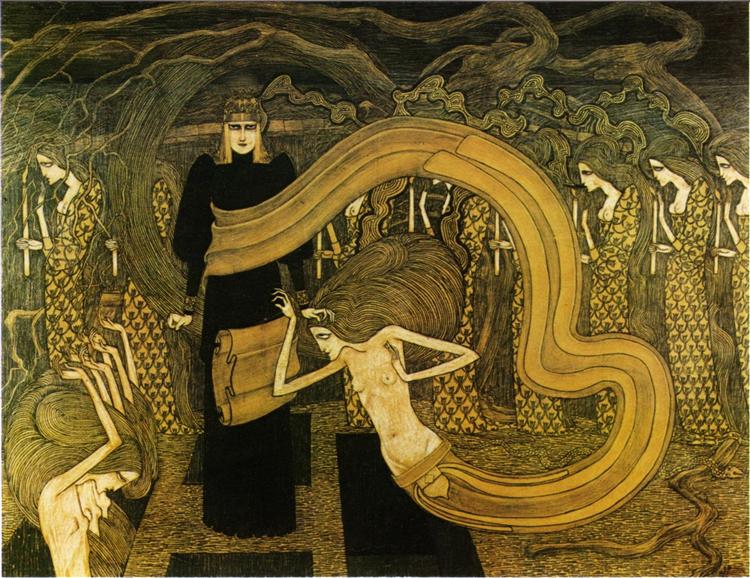Description
The painting "death" (1893), also known as "fatality" in its original English title, is a representative work of its author's symbolism, Jan Toorop, a Dutch artist whose artistic production was marked by a deep exploration of the condition of the condition human and their emotions. In this painting, Toorop uses a palette of gloomy tones and a composition loaded with symbolism to address a theme that is as timeless as universal: death and its inevitable presence in life.
The work is characterized by a vertical composition, in which the central figure of a skeletal monster, which personifies death, occupies an outstanding part of the canvas. This character is represented with a threatening atmosphere, and its form is reminiscent of the Gothic representations of death, with a face that lacks defined features and that evokes a sense of desolation. Death is presented as an entity that is not only feared, but also seems to attract the attention of the viewer, symbolizing the end of life and mystery that surrounds it.
Flanking this central figure are other elements that enrich the visual narrative of the work. Undulating forms and curvilinear lines that characterize the edges of painting seem to act as a contrast to the rigidity of the death figure, referring to the cycles of life and death. The use of light and shadow is deliberate and effective; Toorop creates a dramatic game between clarity and darkness, which gives a powerful emotional load to the scene. Light transitions are subtle and contribute to the creation of an environment of melancholy and contemplation.
The colors used at work are predominantly dark, with nuances of gray, black and brown that dominate, while sketches of lighter tones provide a feeling of hope or, on the contrary, a feeling of fatalism. The impetuous application of the painting and texture of the canvas are characteristics of the symbolist style that Toorop cultivated, and that is reflected in other works of his, such as "Spring" and "The Death of the Mother", in which he explores transitional issues and spirituality.
Toorop, like many of his symbolist contemporaries, distances himself from realistic representations and seeks in his work the expression of abstract ideas and existential concepts. In "death", the artist is not limited to presenting an aesthetic concept, but invites the viewer to reflect on the inevitability of the end and the connection between life and death. This makes the paint a vehicle for the dialogue between the spectator and the work, where each person can interpret and feel the depth of the meaning of different ways.
Although "death" may seem in a first glance a gloomy and pessimistic representation, it is also impregnated with the beauty characteristic of symbolism, where the tragic is intertwined with the sublime. Jan Toorop's work, and in particular this painting, offers us an introspective look to the cycle of life, challenging us to confront and understand what it means to be human in the context of an inevitable ending.
In summary, "death" is erected as a tense exploration of the fragility of life and the constant presence of death. Through his mastery in composition, the use of color and symbolic representation, Jan Toorop allows us not only to observe, but to feel the weight of this universal theme that resonates with each spectator, thus promoting a space for reflection and understanding of our own mortality.
KUADROS ©, a famous paint on your wall.
Hand-made oil painting reproductions, with the quality of professional artists and the distinctive seal of KUADROS ©.
Art reproduction service with satisfaction guarantee. If you are not completely satisfied with the replica of your painting, we refund your money 100%.

